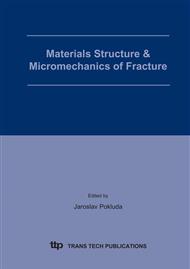p.339
p.343
p.347
p.351
p.355
p.359
p.363
p.367
p.371
Effect of Interfaces on Fiber Fracture in Mg and MgLi Matrix Composites
Abstract:
Fibers fracture in tensile strained Mg and MgLi matrix composites strengthened with ~10% vol. short δ-Al2O3 fibers (Saffil) is investigated by „in-situ“ scanning electron microscopy and ex-situ“ determination of the length of fibers chemically recovered from tensile failed composites. Little interfacial reaction in Mg matrix composite results in poor interfacial bond so that composite failure proceeds via fiber pull-out with negligible fiber fragmentation. On the other hand, extensive fiber/matrix reaction in MgLi matrix composites promotes formation of strong interfaces which are linked with multiple fiber cross-breakage during tensile straining. These results are consistent with experimental tensile strengths of related composites.
Info:
Periodical:
Pages:
355-358
Citation:
Online since:
April 2005
Authors:
Price:
Сopyright:
© 2005 Trans Tech Publications Ltd. All Rights Reserved
Share:
Citation:


